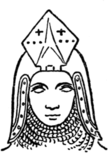spread out over the shoulders, overlapping the cuirass. This was called the "camail," or "curtain of mail." It is shown in Figs. 576 and 577 fastened to the bascinet by a lace or thong passing through staples.
The large helm, which throughout the fourteenth century was still worn over the bascinet, did not fit down closely to the cuirass (though it may have been fastened to it with a leather strap), its bottom curve not being sufficiently arched for that purpose; nor did it wholly rest on the shoulders, but was probably wadded inside so as to fit closely to the bascinet.
It is doubtful if any actual helm previous to the fourteenth century exists, and there are very few of that period remaining. In that of the Black Prince at Canterbury (Fig. 271) the lower, or cylindrical, portion is composed of a front and back piece, riveted together at the sides, and this was most likely the usual form of construction; but in the helm of Sir Richard Pembridge (Figs. 580 and 581) the three pieces (cylinder, conical piece, and top piece) of which it is formed are fixed with nails, and are so welded together that no trace of a join is visible. The edges of the metal, turned outwards round the ocularium, are very thick, and the bottom edge is rolled inwards over a thick wire, so as not to cut the surcoat. There are many twin holes in the helmet for the aiglets, by which the crest and lambrequin were attached, and in front, near the bottom, are two + shaped holes for the T bolt, which was fixed by a chain to the cuirass.
The helm of Sir Richard Hawberk (Figs. 582 and 583), who died in 1417, is made of five pieces, and is very thick and heavy. It is much more like the later form adapted for jousting, and was probably only for use in the tilt-yard; but, although more firmly fixed to the cuirass than the earlier helm, it did not fit closely down to it, as all later helms did.
Singularly few examples of the pot-helmet actually exist. The "Linz" example (Figs. 584 and 585), which is now in the Francisco-

